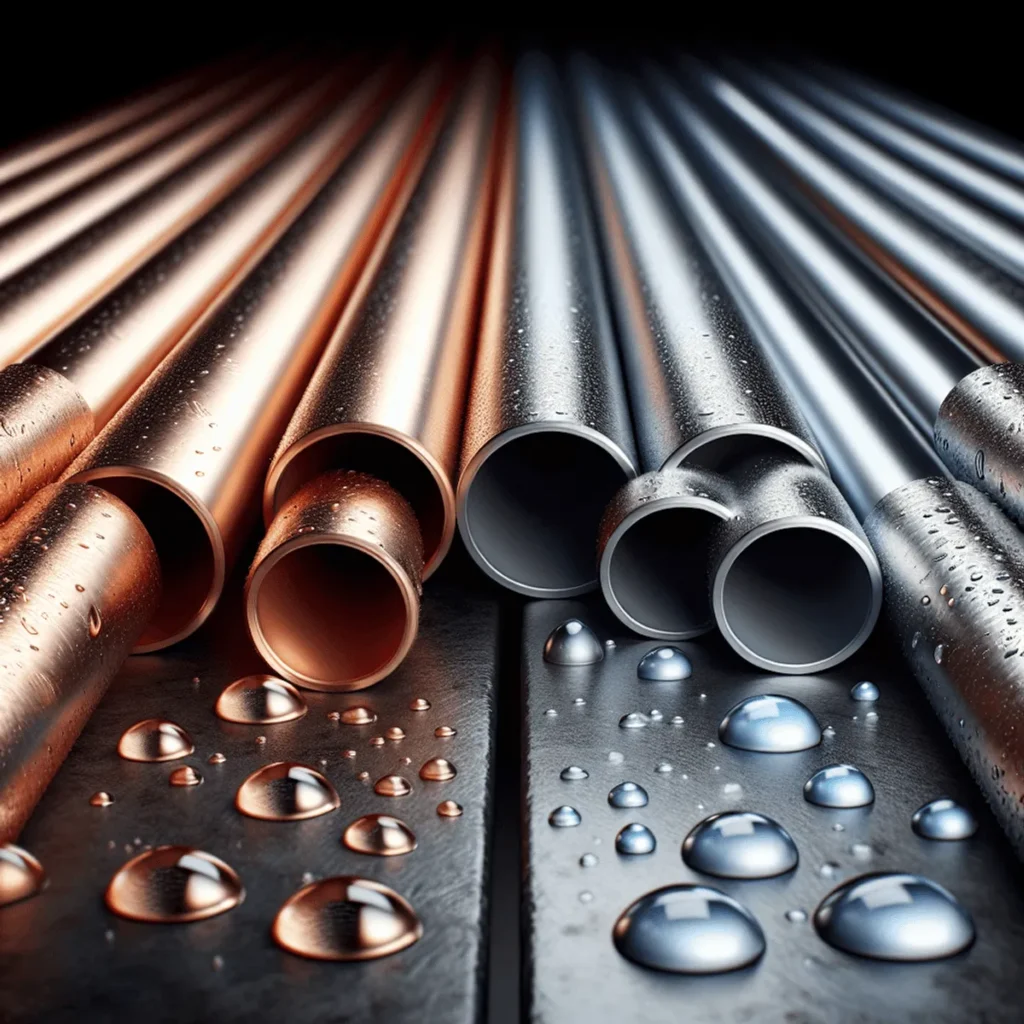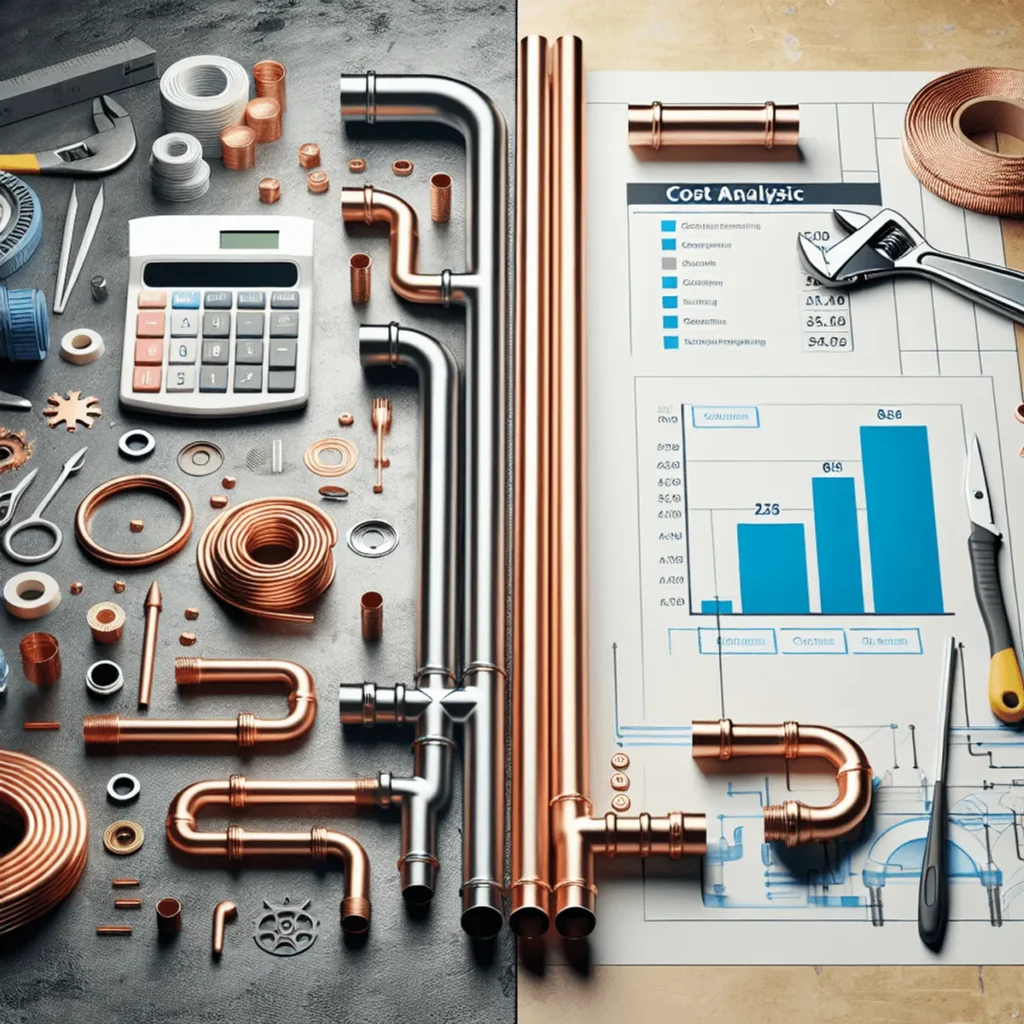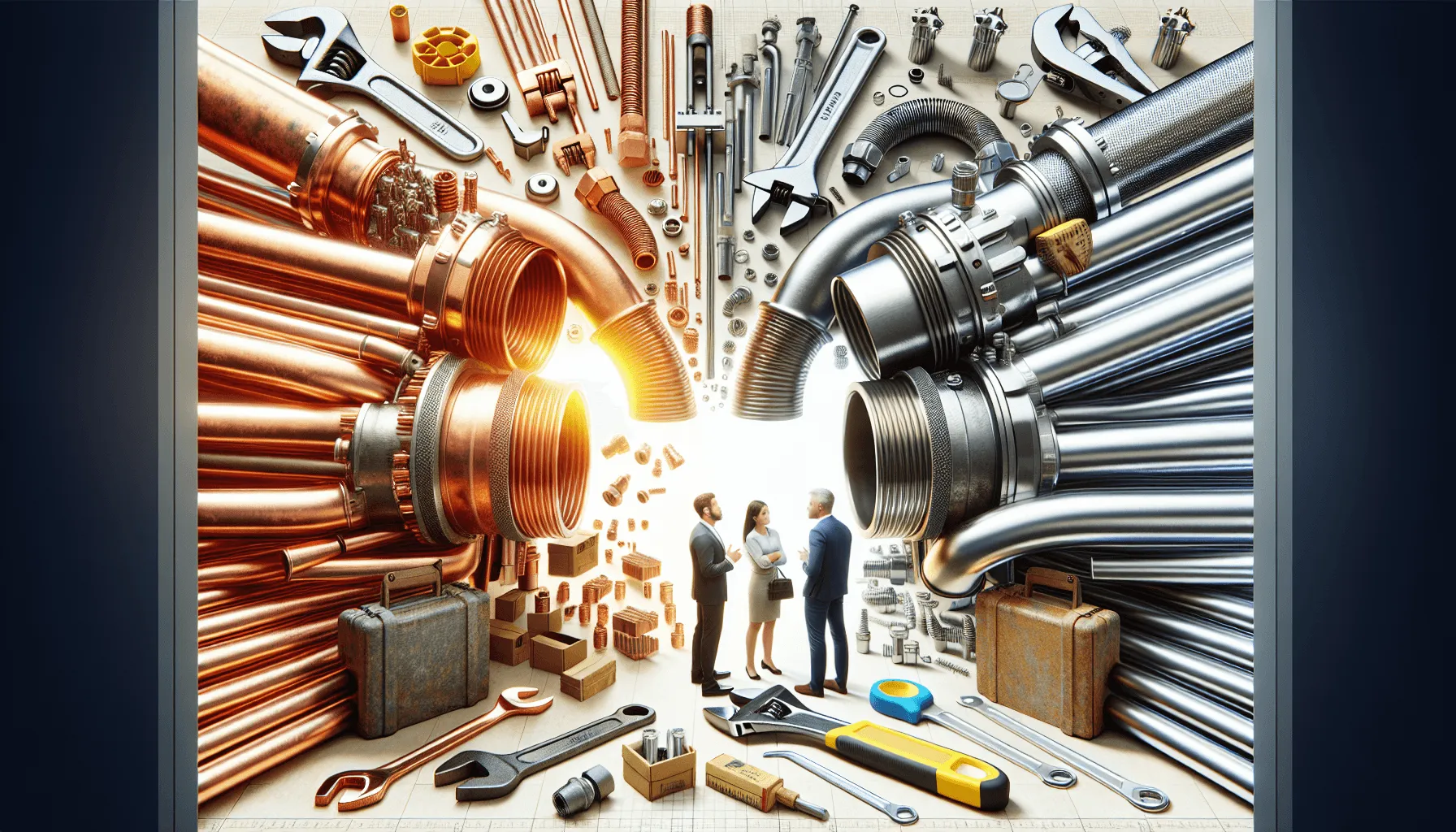Choosing the right material for your home plumbing system is essential. It can greatly affect how long the system lasts, how well it works, and how safe it is. Two of the most popular options are stainless steel pipe and copper plumbing.
Copper Plumbing
Copper plumbing has been used for a long time in homes, businesses, and industries. It’s easy to install because it’s flexible. However, it can corrode from the outside and there may be health concerns with copper ions in drinking water.
Stainless Steel Plumbing
Stainless steel plumbing is strong and resistant to corrosion. It’s also hygienic because bacteria and biofilm can’t grow on it easily. While stainless steel might cost more upfront, its benefits over time often make up for that.
In this article, we’ll compare stainless steel pipe vs copper plumbing in detail. We’ll look at their characteristics, environmental impact, costs, and how they perform in different situations.
Understanding the Materials
Copper Plumbing
Copper has a long history in plumbing, dating back centuries. Used extensively in domestic, commercial, and light industrial applications, copper pipes are known for their versatility and reliability.
Key Advantages of Copper Pipes:
- Malleability: One of the standout features of copper is its malleability. This property makes it easier to cut and bend during installation, allowing for intricate plumbing layouts without the need for numerous fittings.
- Thermal Conductivity: Copper’s high thermal conductivity allows it to retain heat efficiently. This can be beneficial in hot water systems where heat retention is crucial. However, this also means that copper pipes require more insulation to prevent heat loss and save energy.
Copper does have some drawbacks, including its susceptibility to corrosion. When exposed to certain gases or hard water, copper can develop a green oxidation layer. This corrosion can impact the longevity and reliability of the plumbing system.
Stainless Steel Plumbing
Stainless steel is a premium material that offers several advantages over traditional copper plumbing systems. Two main types used in plumbing are 304 and 316 stainless steel.
304 vs. 316 Stainless Steel:
- 304 Stainless Steel: Known for its excellent corrosion resistance and affordability, 304 stainless steel is commonly used in residential plumbing.
- 316 Stainless Steel: This type contains molybdenum, which enhances its corrosion resistance even further. It is often used in more demanding environments like marine applications or areas with harsh water conditions.
For an in-depth comparison between these two types of stainless steel, you may find this article on 304 vs 316 stainless steel useful.
Strength and Durability Compared to Copper:
Stainless steel is approximately 2.5 times stronger than copper in strain/stress tests. This superior strength allows for thinner wall thicknesses while maintaining the same pressure ratings as thicker-walled copper pipes.
Corrosion Resistance Features:
One of the most significant benefits of stainless steel is its remarkable corrosion resistance. Unlike copper, stainless steel does not develop an oxidation layer when exposed to adverse conditions. This makes it especially suitable for environments where corrosion could be a significant issue.
Additionally, stainless steel does not promote bacteria growth or biofilm formation, making it a more hygienic choice for plumbing systems. The material’s durability ensures fewer replacements and repairs over time, bolstering its long-term value proposition.
By understanding these key properties, you can better assess which material—copper or stainless steel—suits your specific plumbing needs.
Comparing Corrosion Resistance, Thermal Properties, and Mechanical Strength

Corrosion Resistance
Understanding corrosion resistance in piping materials is crucial for ensuring the longevity and reliability of your plumbing system.
Copper Pipes
Copper pipes can corrode when exposed to certain gases or hard water, leading to a green oxidation layer known as patina. This layer can affect the structural integrity of the pipes over time. Factors such as water pH and mineral content play a significant role in copper pipe corrosion.
Stainless Steel Pipes
Stainless steel pipes, on the other hand, exhibit superior corrosion resistance due to their chromium content, which forms a passive oxide layer that protects against rust and degradation. Specifically, stainless steel types 304 and 316 are renowned for their high corrosion resistance, with type 316 offering enhanced protection due to its molybdenum content.
Galvanic Corrosion
Galvanic corrosion is another aspect to consider when mixing metals in a plumbing system. When copper and stainless steel come into contact with an electrolyte (such as water), the less noble metal (copper) tends to corrode faster. This phenomenon necessitates careful material selection and installation practices to avoid premature pipe failure.
Thermal Properties
In terms of thermal properties:
- Copper has a higher thermal conductivity compared to stainless steel.
- This means copper pipes are more efficient at heat transfer, making them ideal for applications requiring rapid heating or cooling.
- However, this high thermal conductivity also means that copper pipes require more insulation to prevent heat loss in hot water systems.
- Stainless steel, with its lower thermal conductivity, offers better heat retention in plumbing systems but may not be as efficient for applications requiring quick temperature changes.
- The implications for insulation requirements are significant: copper installations might need extra insulating materials to maintain energy efficiency, while stainless steel systems could operate effectively with less insulation.
Mechanical Strength
The mechanical strength of piping materials affects their performance under pressure and physical stress:
- Stainless steel is approximately 2.5 times stronger than copper, which allows for thinner wall thicknesses while maintaining the same pressure ratings.
- This increased strength translates into higher tensile strength and better resistance to physical impacts and vibrations.
For instance:
- Stainless Steel: With greater tensile strength, stainless steel pipes require less support and can withstand higher pressures without deforming.
- Copper: While easier to cut and bend due to its malleability, copper is softer and more susceptible to damage from physical impacts.
The impact on wall thickness is notable; stainless steel’s strength allows for thinner walls without compromising durability, offering potential cost savings on material usage while ensuring robust performance under varying conditions.
Understanding these comparative properties helps you make an informed decision based on your specific needs and constraints for your home plumbing system.
Environmental Considerations: Sustainability of Piping Materials, Health Implications
Sustainability of Piping Materials
The environmental impact of manufacturing processes for both stainless steel and copper is a significant factor when considering the sustainability of piping materials. Copper mining and refining are energy-intensive processes that often result in habitat destruction and water pollution. In contrast, producing stainless steel, while also energy-consuming, generally has a lower carbon footprint due to more efficient production methods and the use of recycled materials.
Recyclability plays a crucial role in the sustainability of both materials. Stainless steel is 100% recyclable, which means it can be reused without degradation in quality. This makes it an environmentally friendly choice for plumbing systems. Copper is also highly recyclable; however, its recycling process can be more complex and less efficient compared to stainless steel. The use of reusable metal straws made from materials like stainless steel further exemplifies the sustainability potential of such metals.
Health Implications
Health risks from drinking water contaminated with metals are a critical concern. Copper pipes can sometimes leach copper ions into the water supply, especially in corrosive environments. While copper is an essential nutrient in small amounts, excessive copper intake can lead to health issues such as gastrointestinal distress and liver or kidney damage.
Stainless steel offers hygiene advantages over copper due to its resistance to corrosion and low propensity to leach harmful substances into the water supply. It does not promote bacterial growth or biofilm formation, ensuring a cleaner and safer plumbing system. This makes stainless steel an attractive option for those prioritizing health and hygiene in their home plumbing systems.
By understanding these environmental considerations and health implications, you can make an informed decision between stainless steel pipe vs copper plumbing for your home.
Cost Analysis: Initial Costs vs. Long-term Value, Installation Costs

Initial Costs vs. Long-term Value
When evaluating the cost of plumbing materials, it’s critical to distinguish between initial installation costs and long-term value.
Copper Plumbing:
- Initial Costs: Copper pipes are generally more affordable upfront compared to stainless steel. A common price range for copper piping is $2 to $4 per linear foot.
- Long-term Maintenance: Copper requires regular maintenance due to potential corrosion and wear over time. This can add up in terms of both cost and effort. The need for additional insulation to prevent heat loss can also increase long-term expenses.
Stainless Steel Plumbing:
- Initial Costs: Stainless steel pipes have a higher initial cost, typically ranging from $3 to $6 per linear foot. This is due to their superior material properties and manufacturing processes.
- Long-term Maintenance: Although the initial investment is higher, stainless steel offers better long-term value. Its high durability, corrosion resistance, and lower maintenance needs translate to fewer replacements and repairs over time.
Installation Costs
Installation costs play a significant role in the total expenditure for plumbing systems.
Copper Plumbing:
- Complexity and Time: Copper’s malleability makes it easier to cut and bend during installation, which can reduce labor time. However, soldering joints require skill and precision.
- Labor Costs: Labor costs for copper installations are generally moderate but can vary based on local labor rates and the complexity of the project.
Stainless Steel Plumbing:
- Complexity and Time: Despite its rigidity, stainless steel often comes with pre-fabricated joints and fittings that simplify installation. The process is generally faster due to fewer required connections.
- Labor Costs: While the material itself is pricier, the reduced installation time can offset some of these costs. Additionally, stainless steel’s longer lifespan means fewer disruptions and labor needs in the future.
A cost comparison of stainless steel copper reveals that while stainless steel demands a higher initial outlay, its long-term advantages often justify the investment. On the other hand, copper’s lower upfront cost makes it an attractive option for budget-conscious projects despite higher maintenance expenses down the line.
Performance in Various Applications: High-Velocity Applications, Water Treatment Systems
High-Velocity Applications
When it comes to high-velocity applications, the performance of plumbing materials under high flow rates is crucial. Stainless steel shines in these scenarios due to its superior strength and resistance to corrosion.
Advantages of Stainless Steel
- Strength and Durability: Stainless steel maintains its integrity even under intense pressure, ensuring minimal risk of leaks or pipe bursts.
- Corrosion Resistance: High flow rates can accelerate corrosion in metals; however, stainless steel’s robust anti-corrosive properties make it an ideal choice for such conditions. This is a significant advantage highlighted in discussions about the future of plumbing with corrosion-resistant pipes.
- Applications: This makes stainless steel suitable for industrial settings and commercial buildings where high water flow is the norm.
Limitations of Copper
In contrast, copper also performs well but comes with certain limitations:
- Corrosion Susceptibility: While copper is generally resistant to corrosion, high-velocity water flow can lead to erosion-corrosion, reducing the lifespan of the pipes.
- Heat Retention: Copper’s higher thermal conductivity can be both an advantage and a drawback. It ensures efficient heat transfer but requires more insulation to prevent heat loss.
Water Treatment Systems
Water treatment systems demand materials that ensure purity and longevity. Both stainless steel and copper have their own set of advantages and disadvantages in these environments.
Stainless Steel
- Hygiene: Stainless steel does not promote bacterial growth or biofilm formation, making it a hygienic option for water treatment systems.
- Durability: Its resistance to various chemicals used in water treatment processes ensures long-term reliability.
- Use Cases: Often used in desalination plants, sewage treatment facilities, and drinking water purification systems due to its superior qualities.
Copper
- Antimicrobial Properties: Copper’s natural antimicrobial properties make it effective in inhibiting the growth of harmful bacteria.
- Chemical Interaction: However, certain chemicals in water treatment processes can accelerate corrosion in copper pipes.
- Applications: Suitable for residential water treatment systems where chemical exposure is less severe compared to industrial settings.
Evaluating these factors helps you choose the right material based on specific needs—whether it’s handling high flow rates or ensuring the highest level of hygiene in water treatment environments.
Conclusion
When it comes to choosing between stainless steel and copper plumbing, your decision should align with your specific project needs. Both materials have their benefits and drawbacks.
Stainless Steel:
- Strength and Durability: Ideal for high-pressure systems due to its superior mechanical strength.
- Corrosion Resistance: Provides excellent resistance to corrosion, ensuring longevity.
- Hygiene: Does not promote bacterial growth, making it suitable for potable water systems.
- Sustainability: Fully recyclable with a lower carbon footprint.
Copper Plumbing:
- Malleability: Easier to work with during installation due to its flexibility.
- Thermal Conductivity: Better heat retention, beneficial for hot water systems.
- Traditional Use: Long history of use, offering reliability in various applications.
To compare stainless steel and copper pipes effectively:
- Budget Constraints: Copper might be more cost-effective initially but consider the long-term value of stainless steel.
- Environmental Impact: Stainless steel has a greener footprint and is completely recyclable.
- Health Considerations: Stainless steel avoids the potential health risks associated with copper leaching.
- Application Requirements: High-pressure or hygienic environments benefit more from stainless steel, while traditional settings might find copper adequate.
Your choice will ultimately depend on balancing these factors against your project’s specific requirements.
FAQs (Frequently Asked Questions)
What are the main differences between stainless steel and copper plumbing materials?
Stainless steel pipes are known for their durability and corrosion resistance, while copper pipes offer excellent malleability and thermal conductivity. This article provides a comparison of these two materials to help you choose the right one for your plumbing system.
How does corrosion affect copper and stainless steel pipes?
Copper pipes can be susceptible to corrosion, particularly from galvanic reactions in mixed metal systems. Stainless steel, on the other hand, exhibits superior corrosion resistance due to its composition. Understanding these factors is crucial when selecting piping materials.
What are the thermal properties of stainless steel compared to copper?
Copper has higher thermal conductivity than stainless steel, which means it retains heat better. This can influence insulation requirements in plumbing systems. However, stainless steel offers greater strength and durability under varying temperature conditions.
Are there any health implications associated with using copper pipes?
Yes, there can be potential health risks due to copper leaching into drinking water. While copper is essential for health in small amounts, excessive exposure can lead to health issues. Stainless steel offers hygiene advantages as it does not leach into water.
How do initial costs compare between stainless steel and copper plumbing?
Initial costs for both materials vary, with copper often being less expensive upfront. However, long-term maintenance costs and durability may make stainless steel more cost-effective over time. Installation complexity and labor costs also play a significant role in overall expenses.
In what applications do stainless steel and copper pipes perform best?
Copper pipes are commonly used in residential plumbing due to their flexibility and ease of installation, while stainless steel pipes excel in high-velocity applications and water treatment systems due to their strength and resistance to corrosion.


Comments are closed